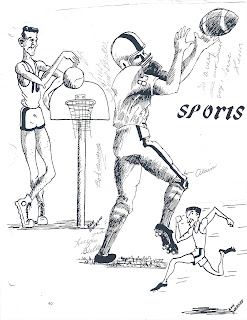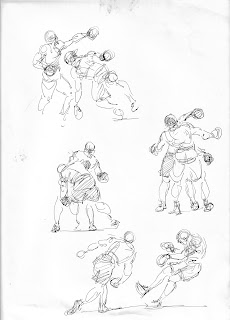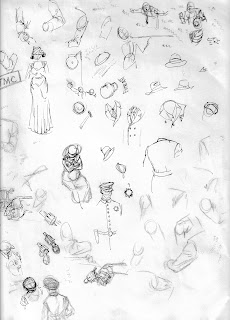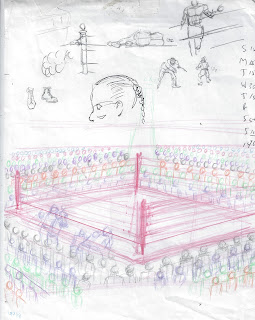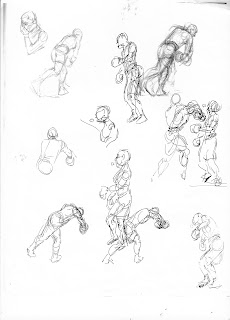11/11/2019... Official start date.
The H pencil on Strathmore 500, 2-ply, 23" by 29" illustration board. Sounds a little technical but it is what I find works best for the technique of pen and ink, cross hatching. I'll talk more about pen and ink next time.
11/23/19...
The boxing ring size, angle and format is set (below). This would be the environment which the individual actors would perform. Sounds like I'm making a movie and in a way I am. Think about how important the layout/background is in anchoring the setting and giving the actors the proper setting to convey the story points. My thinking goes like this...in a quick sketch or an illustration you are telling a story in a single sketch/drawing. In a movie (animated or live action) your story is told in a series of images run through a projector at 24 frames per second.
My background in animation has me thinking not only about a strong, storytelling pose (extreme) but how the character got into the pose and how the character is going to get out of that pose. Thus, the character drawn has a feeling of movement, even in a stationary pose.
Everything that describes that particular character is explained in that one drawing. Body language and facial expression must say it all about him or her at that moment in time.
12/21/19...
First in importance is the placement of the ring posts (above). Foreground, left and far corner. To include the whole four corners of the ring I would have to draw the individuals smaller. What I wanted to say about each individual was not only in their body language but also in their faces. What was more important in telling this story, the ring or the size of the attendees? No contest.
Next was to position the catalyst of all the commotion, the boxers. Rather than drawing and re-working the main characters on the illustration board which meant much erasing and wearing down the surface of the paper, I worked it out on tracing paper...
12/16/19...
then (below) penciled the images in.
.
12/17/19.... With the two main characters in place I begin to add the people. Beginning with the referee. The overall theme is to have all the people reacting to the knockout punch, the referee (below) is no exception as he recoils from the vicious blow. But as more people are added, the ref will help bring out another aspect of how this story is told.
12/18/19...
The people (right) were added in small groups around the boxing ring. This way I had a feel for perspective, proportion and scale from all angles.
Everybody is engaged and doing something based on their mutual interest in the boxing match.
1/6/20...
At the early stage keeping silhouettes was easy, making sure everyone stood out would be more challenging as the population (below) on paper increased.
1/19/20...
There are a number of servicemen depicted. The excited sailor (above, left) is my son-in-law Johann. He is presently active duty Navy (C.U. below) and helped me by researching navy uniforms of that era.
As more people were added I wanted to convey the feeling that everything was being motivated by this one act, the knockout punch. All eyes and bodies, for the most part, were focused in that direction.
The referee (below) is not in the same body position he was in at the beginning. I saw an opportunity to get the referee to bend his body toward the action and further lead the eye into the action. From the beginning planning stages it was my intent to lead the eye toward the action by using the boxing ring pole nearest to the viewer. Follow the pole to the boxer's right foot, up to his body, through his right arm into the impact of the blow that ignites the emotions of the crowd. This will be further emphasized during the inking process.
1/23/20...
All penciling done (below) the illustration goes to the printer to get a scanned image at this stage.
Finally in part 3 I'll discuss the inking process.
Until next time...


